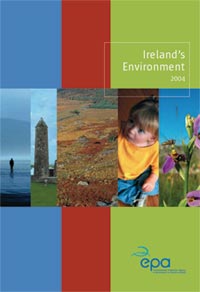| 2004 |

|
YEAR BOOK |
The Environmental Protection Agency
|
Ireland's Environment 2004
– state of the environment report
|


In recent years, there have been positive signals for the environment: a slow-down in the growth of greenhouse gas emissions, continued reduction in emissions of some acidifying gases, and progress on reducing the extent of rivers affected by eutrophication. Over a longer period, there has been a significant reduction in serious pollution of rivers and in urban air pollution by lead from petrol and smoke from coal. Irish people are becoming more aware of and concerned with environmental issues and more willing to act in environmentally friendly ways. Examples include the plastic bag levy, which has removed over one billion plastic bags from use each year, and the increased rates of recycling of municipal waste.
In spite of the positive signals, much more progress is required on priority issues such as eutrophication, waste management and greenhouse gas emissions. Greenhouse gas emissions are currently 29 per cent above 1990 levels, and a reduction to 13 per cent above 1990 levels is required by 2008–2012 to meet Ireland's Kyoto obligations. Progress on waste recovery and recycling has been counterbalanced by the overall growth in waste produced. Eutrophication remains the most widespread water pollution problem with 44 lakes, 10 estuaries and over 3,800 km of river and stream channel affected. Further progress is needed too on the protection of natural resources and on ameliorating the impact of transport on the urban environment. What is now needed is to make the protection of the environment and the conservation of natural resources central considerations in the plans, programmes and actions of all economic sectors.
There has been considerable investment through the National Development Plan into much needed environmental infrastructure and environmental research. In recent years too, there are adopted strategies and plans such as the National Biodiversity Plan, National Climate Change Strategy and National Spatial Strategy. The challenge now is to ensure that the objectives and targets of these plans become part of day-to-day decision making. A continuation of the positive signals depends critically on the objectives of the various strategies and plans being realised in a timely manner.
Contact: Annmarie Tuohy, Environmental Protection Agency,
PO Box 3000, Johnstown Castle Estate, Co. Wexford;
Ph: 053 60600